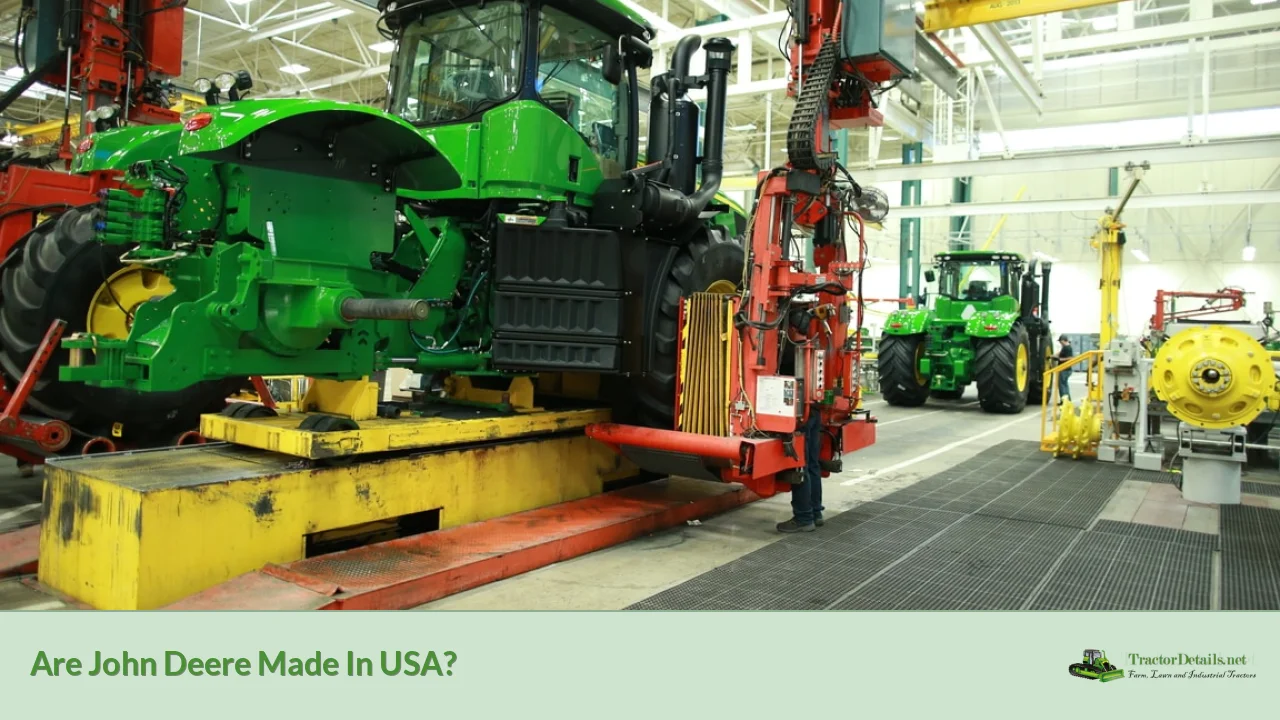John Deere is a name synonymous with agricultural machinery and equipment, deeply rooted in American history since its founding in 1837. The company has grown significantly over the years, becoming a leading manufacturer of tractors and other heavy equipment. However, the question of whether John Deere products are made in the USA is complex. While John Deere maintains a strong presence in the United States, it also operates numerous manufacturing facilities around the world.
The company has 15 main manufacturing facilities in the USA, with additional factories located in countries such as China, Germany, and India. Notably, many of their larger tractors are produced in the United States, particularly in Iowa and Georgia. However, some models are manufactured abroad to meet global demand. This article will explore where John Deere products are made, highlighting the balance between domestic manufacturing and international operations.
| Location | Type of Products Manufactured |
|---|---|
| Waterloo, Iowa | Agricultural tractors |
| Augusta, Georgia | Compact utility tractors |
| Greeneville, Tennessee | Lawn and garden tractors |
| Horicon, Wisconsin | Lawn and garden tractors |
John Deere's Manufacturing Facilities in the USA
John Deere operates several manufacturing plants across the United States. Each facility specializes in producing specific types of equipment. Here’s a closer look at some of the key locations:
- Waterloo, Iowa: This facility is one of the largest and most significant for John Deere. It produces various agricultural tractors, including popular models like the 7R, 8R, and 9R series. The Waterloo plant has been operational since 1918 and is known for its extensive production capabilities.
- Augusta, Georgia: This plant focuses on compact utility tractors and utility tractors. It plays a crucial role in meeting the demand for smaller farming equipment that is versatile for various tasks.
- Greeneville, Tennessee: Specializing in lawn and garden tractors, this facility contributes to John Deere's extensive product line aimed at residential customers and small-scale agricultural needs.
- Horicon, Wisconsin: Also dedicated to lawn and garden equipment, this plant produces a range of products designed for landscaping and home use.
These facilities collectively support thousands of jobs in the American workforce and contribute significantly to local economies.
Global Manufacturing Operations
While John Deere maintains a robust manufacturing presence in the USA, it also operates internationally to cater to a broader market. The company has established factories in several countries to meet local demands efficiently:
- China: John Deere has multiple plants in China that produce various agricultural machinery. The Tianjin facility is particularly notable for its production of tractors since 2012.
- Germany: The Mannheim plant is another key location for John Deere's operations outside the USA. It has produced millions of tractors since its inception and serves as a development center for new models.
- India: John Deere has expanded its manufacturing capabilities into India with plants located in Pune and Dewas. These facilities focus on producing agricultural equipment tailored to local markets.
This global strategy allows John Deere to remain competitive while ensuring that they can meet diverse customer needs across different regions.
The Impact of Global Manufacturing on American Jobs
Despite having significant manufacturing operations abroad, John Deere remains committed to supporting American jobs. Approximately 75% of all products sold in the U.S. are assembled within the country. This commitment is essential not only for maintaining quality control but also for supporting local economies through job creation.
Moreover, John Deere is considered a net exporter of U.S.-assembled agricultural equipment. This means that while some products are manufactured internationally, many components are still produced domestically before being shipped worldwide.
Models Manufactured in the USA
Several popular models of John Deere tractors are manufactured in the United States. These include:
- 7R Series Tractors
- 8R Series Tractors
- 9R Series Tractors
- 6M Series Mid-Range Tractors
- 2032 Compact Utility Tractors
- X7 Series Lawn and Garden Tractors
These models highlight John Deere's commitment to producing high-quality machinery that meets the needs of American farmers and homeowners alike.
Consumer Perception of American-Made Products
The perception of American-made products carries significant weight among consumers. Many customers prefer purchasing items that support local economies and labor forces. As such, John Deere's marketing often emphasizes its American roots while also being transparent about its global operations.
This dual approach allows consumers to feel confident that they are investing in quality products while also supporting American jobs. However, it can sometimes lead to confusion regarding which specific models are made domestically versus internationally.
FAQs About Are John Deere Made In USA
- Are all John Deere tractors made in the USA?
No, not all tractors are made in the USA; some are manufactured internationally. - Where are most John Deere tractors manufactured?
Most large agricultural tractors are manufactured in Waterloo, Iowa. - Does John Deere produce any equipment outside of the USA?
Yes, John Deere has manufacturing facilities in countries like China and Germany. - What percentage of John Deere products sold in the U.S. are made domestically?
Approximately 75% of all products sold within the U.S. are assembled domestically. - Which models of John Deere tractors are made in America?
The 7R, 8R, 9R series tractors, along with several compact utility models.
In conclusion, while John Deere maintains a prominent manufacturing presence within the United States—producing many key models domestically—it also operates globally to meet international demand efficiently. This strategy not only supports American jobs but also enables the company to remain competitive on a worldwide scale. Understanding where these machines come from can help consumers make informed purchasing decisions while appreciating both local craftsmanship and global manufacturing capabilities.
